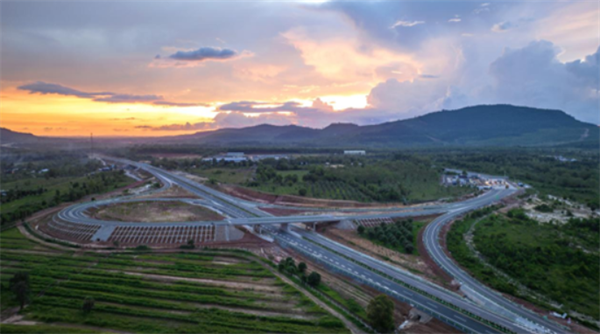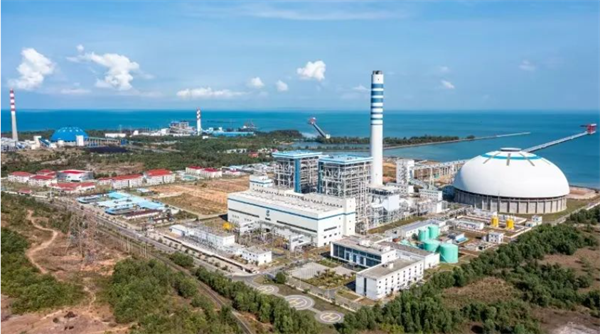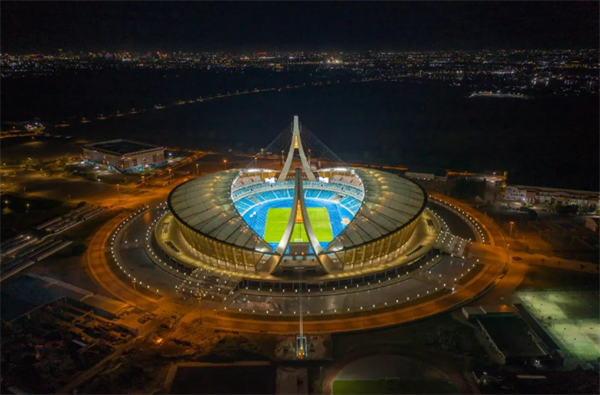In recent years, under the framework of the Belt and Road Initiative (BRI), Chinese central state-owned enterprises (SOEs) have actively integrated into the Cambodian market. Prioritizing sustainability and improving the welfare of the people, these enterprises are committed to building a high-quality China-Cambodia community with a shared future.
Promoting agricultural and trade cooperation for mutual benefit
Capitalizing on Cambodia’s natural endowments and China’s market and technological strengths, the two countries have achieved mutually beneficial agricultural and trade cooperation.
COFCO Corporation (COFCO) has actively supported Cambodia’s agricultural growth through rice trade under the BRI. After nearly a decade of efforts, China has become the largest exporter of Cambodian rice.
The company has fully leveraged its nationwide sales network to increase Cambodian rice’s market visibility in China. In 2021, COFCO launched its “KING FOOD” line of imported Cambodian rice and worked closely with the Cambodia Rice Federation to promote the premium “MALYS ANGKOR” jasmine rice brand, significantly boosting brand recognition in the Chinese market.
In addition, COFCO has helped local farmers optimize crop structures, diversify rice export varieties, improve processing capabilities, and enhance product quality.
Since 2020, China National Research Institute of Food & Fermentation Industries, a subsidiary of China Poly Group Corporation (Poly Group)’s Sinolight Corporation, has undertaken a major national R&D project focused on key technologies for food manufacturing and quality control in Cambodia. It has organized multiple foreign aid training sessions to share advanced food processing and testing technologies, helping upgrade Cambodia’s agricultural processing capabilities.
Enhancing infrastructure for social development
Chinese central SOEs have been instrumental in improving Cambodia’s infrastructure, enhancing connectivity and energy access to drive economic development.
The Phnom Penh–Sihanoukville Expressway, Cambodia’s first expressway, was built and operated by China Communications Construction Company Limited (CCCC). Spanning 187.05 kilometers and linking five provinces, the expressway has reduced travel time between Phnom Penh and Sihanoukville from over five hours to under two since it opened for trial operation on October 1, 2022. The route has lowered logistics costs and accelerated economic activity. On June 7, 2023, CCCC also initiated construction on the Phnom Penh–Bavet Expressway, Cambodia’s second expressway.

The Phnom Penh–Sihanoukville Expressway [Photo/sasac.gov.cn]
China Railway 16th Bureau Group Corporation Limited, a subsidiary of China Railway Construction Corporation Limited (CRCC), completed a 40-kilometer rehabilitation project of the Northern Railway Line in 2017, reviving a critical freight route between Phnom Penh and Sihanoukville. Since 2005, Poly Changda Engineering Co., Ltd., a subsidiary of Poly Group, has delivered multiple landmark infrastructure projects in Cambodia, including National Road No. 7.
The terminal of Siem Reap Angkor International Airport, jointly built by China Railway Huatie Engineering Design Group Co., Ltd., was officially opened on November 16, 2023. Meanwhile, the New Phnom Penh International Airport, developed by China State Construction Engineering Corporation (CSCEC), is being built in three phases and is designed to handle 50 million passengers annually. Upon completion, it will be Cambodia’s first 4F-class international airport and a major new gateway to the world.

Siem Reap Angkor International Airport [Photo/sasac.gov.cn]
Supporting Cambodia’s power infrastructure development
Chinese central SOEs have invested in developing Cambodia’s power infrastructure to ensure stable and reliable electricity for the population.
The Sihanoukville power plant, constructed by China Huadian Corporation Ltd (CHD), went into operation at the end of 2022. Built entirely with Chinese standards, technology and equipment, it is Cambodia’s largest and most advanced thermal power plant. As the country’s top power producer, CHD supplies nearly one kilowatt-hour for every 2.5 consumed in Cambodia.

A view of the Sihanoukville power plant [Photo/sasac.gov.cn]
The Lower Sesan 2 Hydropower Station — Cambodia’s largest — was invested by China Huaneng Group Co., Ltd. and constructed by Power Construction Corporation of China (POWERCHINA) and China Energy Engineering Group Co., Ltd. (Energy China). The 400-megawatt station accounts for 20 percent of Cambodia’s total installed power capacity. It is a prime example of Chinese standards, technology, equipment, and management in overseas infrastructure.
The Kamchay Hydropower Station, developed by POWERCHINA, marked China’s largest overseas investment project at the time. Meanwhile, the Kirirom I Hydropower Station, built by CCCC, was the first BOT hydropower project developed by a Chinese company in Cambodia and significantly alleviated local power shortages.
Several major projects by Chinese central SOEs are currently advancing across Cambodia, further enhancing the country’s energy infrastructure.
Energy China is building a 200 MW dual-fuel power plant, which is expected to generate 1.75 billion kilowatt-hours of electricity annually upon completion. China National Machinery Industry Corporation (Sinomach) is developing a 60 MW photovoltaic power project that utilizes bifacial double-glass modules to improve energy conversion efficiency. China Datang Corporation Ltd. has undertaken a 230 kV transmission line project connecting Phnom Penh, Pursat, and Battambang. The new infrastructure has significantly improved the delivery of electricity generated by hydropower stations in western Cambodia.
Meanwhile, a 500 kV transmission project linking Phnom Penh and Laos is underway, with Shandong Electrical Engineering & Equipment Group Co., Ltd. supplying 35,000 tons of angle towers for the cross-border line.
Built by Sinomach’s China National Heavy Machinery Corporation, nearly 14,000 km of transmission lines and 31 substations helped increase Cambodia’s rural electrification rate from 20.3 percent in 2007 to 98.27 percent in 2022.

A 500 kV transmission project linking Phnom Penh and Laos is underway. [Photo/sasac.gov.cn]
Driving Cambodia’s modernization with boosting industry
Through the construction of industrial parks, factories, and commercial complexes, Chinese central SOEs are helping diversify Cambodia’s economy and transform its industrial structure.
The second phase of Samanea Phnom Penh Market, built by China Construction Fourth Engineering Division Corp. Ltd, covers 500,000 square meters. Once completed, it will become Cambodia’s largest commercial complex — integrating e-commerce, trade, leisure, residential, and public services — and serve as a new hub for cross-border trade.
The Kratie Doublestar Tire Factory, constructed by CRCC Harbour and Channel Engineering Bureau Group Co., Ltd., was completed in May 2024. Covering 42,000 square meters, the facility includes warehouses and fire control infrastructure, and is expected to create numerous local jobs, marking a leap forward for Cambodia’s industrial development.
A nitrile glove factory in Manhattan Special Economic Zone, built by China Railway 16th Bureau Group Corporation Limited, began operation in October 2022. It can produce 600 million surgical and medical-grade gloves annually, advancing Cambodia’s manufacturing sector toward high-end medical and protective equipment.
The Cambodia National Stadium, constructed by CSCEC and inaugurated in 2021, has become a new architectural icon in Phnom Penh. Serving as the main venue for the Southeast Asian Games, the stadium also regularly hosts public fitness events, helping to address Cambodia’s shortage of modern sports facilities and driving Phnom Penh’s urban renewal and tertiary industry development.

Cambodia National Stadium [Photo/sasac.gov.cn]
Deepening people-to-people exchanges
The growing trade and investment between China and Cambodia has opened up new avenues for cultural exchange. Chinese central SOEs have played an active role in fostering mutual understanding and friendship through education, tourism, public welfare and healthcare initiatives.
China Duty Free Group Co., Ltd. (CDFG) under China Tourism Group has been operating in Cambodia since 2013, with duty-free stores in Siem Reap, Sihanoukville and Phnom Penh. By creating culturally immersive shopping experiences and offering local-themed creative products, CDFG has become a platform for cultural exchange between the two nations.
During the construction and operation of the Phnom Penh-Sihanoukville Expressway, CCCC employed mostly local workers. The expressway has since become a cradle for developing Cambodia’s highway talent.
China Civil Engineering Construction Corporation (CCECC), a subsidiary of CRCC, has partnered with Cambodian universities and vocational institutions to establish talent development agreements. These include internships and training programs tailored to produce skilled technical and management personnel, helping accelerate local talent growth.
CHD, in collaboration with North China Electric Power University and Guangxi Vocational College of Water Resources and Electric Power, established a training center and an international talent base, providing over 1,500 local employees with Chinese-language and hydropower skills.
Promoting education and healthcare to benefit local communities
China Datang Corporation Limited. has long supported education in Cambodia. In 2014, the company funded and constructed a new building for a middle school in Kandieng, Pusat Province, significantly improving local educational infrastructure. China Datang’s subsidiary in Cambodia also donated sports equipment and educational supplies to a high school and primary school in Pursat Province.
In November 2024, COSCO SHIPPING Charity Foundation and China Foundation for Rural Development jointly launched the initiative for donating bicycles. COSCO SHIPPING transported 3,000 donated Hello-branded shared bicycles from Shanghai to Cambodia and Laos, offering a practical solution for students in rural areas to commute to school. Since 2022, the program has delivered over 6,000 bicycles to countries along the Belt and Road.
In 2018, China Sinopharm International Corporation, under China National Pharmaceutical Group Co., Ltd. (Sinopharm), carried out a major donation of 40 customized mobile clinic vehicles tailored to Cambodia’s healthcare needs. These clinics have significantly improved access to medical services in remote areas. Medical teams from Sinopharm Dongfeng General Hospital have traveled over 5,000 kilometers across rural Cambodia, providing free consultations and treatment to thousands of patients.
(Executive editor: Wang Ruoting)